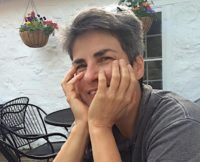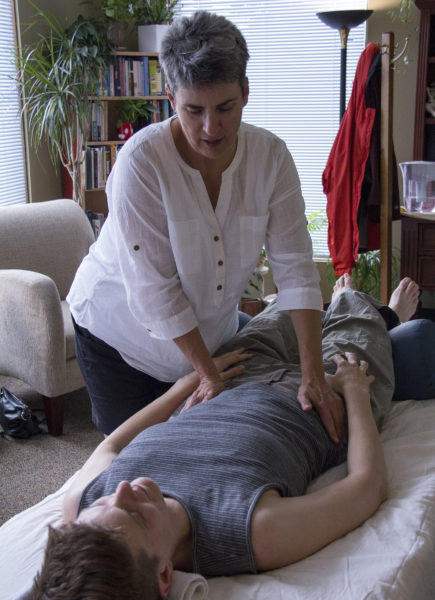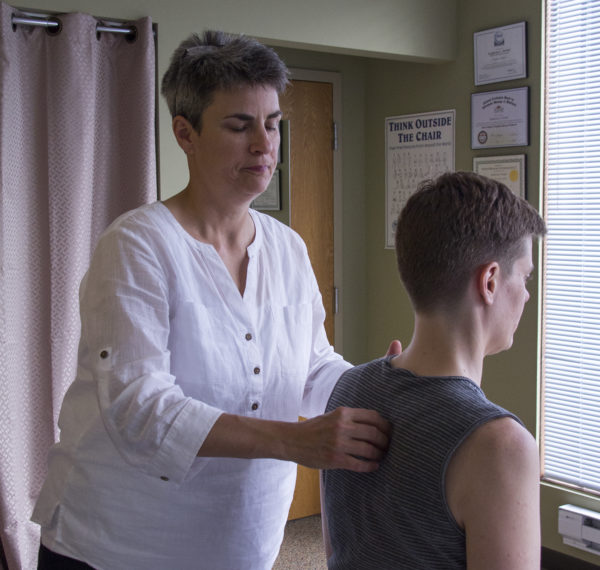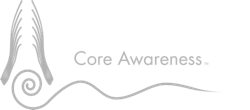Katie Dubel is a U.S. Registered Practitioner of Ortho-Bionomy ® in the Chicago area focusing on restorative bodywork, trauma resolution, and the development and maturation of the proprioceptive and autonomic nervous systems. Katie joined me for her first workshop in 2010 in North Carolina. Since that time, she has attended a variety of workshops and online courses, completed my Application Course for professionals, and joined me for my intensive Advanced Core Awareness Course in Lawrence Kansas. I have personally experienced Katie’s style of hands on work and appreciate her sensitive and profound ability to follow the bio-intelligence of the human organism. Ortho-Bionomy ® is a system of work I deeply respect. I was honored to be their keynote speaker at the 2008 International Ortho-Bionomy ® Conference held in Albuquerque, New Mexico.
® is a system of work I deeply respect. I was honored to be their keynote speaker at the 2008 International Ortho-Bionomy ® Conference held in Albuquerque, New Mexico.
Tell the readers a little about how and why you became an Ortho-Bionomy® practitioner. What in particular drew you towards this particular form of work?
 My earliest experience of health care was with my grandfather who was a Chiropractor. A peer whom my grandfather corresponded with regularly was Major DeJarnette who created a cranial reflex system called sacral occipital technique (SOT). My grandfather utilized SOT exclusively in the later years of his practice. The system seemed like magic to me. The shifts, movements, and releases all came from within and I felt my body’s “knowing.” There was no need to force the body to do anything. I realize now I was experiencing the innate intelligence of my body. I had conversations with my grandfather about following him into the Chiropractic field, but it was not my path.
My earliest experience of health care was with my grandfather who was a Chiropractor. A peer whom my grandfather corresponded with regularly was Major DeJarnette who created a cranial reflex system called sacral occipital technique (SOT). My grandfather utilized SOT exclusively in the later years of his practice. The system seemed like magic to me. The shifts, movements, and releases all came from within and I felt my body’s “knowing.” There was no need to force the body to do anything. I realize now I was experiencing the innate intelligence of my body. I had conversations with my grandfather about following him into the Chiropractic field, but it was not my path.
In the mid 90’s I began training to become a massage therapist. I picked my school for its diverse electives, such as reflexology, which was my love at that time. My first hands-on class was in Ortho-Bionomy®. It was packed with over 30 students, some of who were taking it for the 2nd, 3rd and 4th time. They talked about how ‘OB’ had changed their lives and that they used the principles every day. During the first class, I felt my reflexes engage in a way that was similar to when my grandfather worked with me. My body’s knowing was again being supported. Ortho-Bionomy® gave me a context for what once seemed like magical changes. We learned to support and resource patterns, engage reflexes, and support nervous system responsiveness. It is now 20 years later, and I am still living the principles of Ortho-Bionomy®, which enriches my life every day. Even before I graduated from massage school it was clear to me that the ease and effectiveness of Ortho-Bionomy® was what I wanted to be practicing and that Ortho-Bionomy® was my professional path.
Explain some of the history and the basic premise of Ortho-Bionomy® to our readers. In what ways is it unique from other massage and bodywork systems? Explain how it relates to increasing or promoting proprioception.
Ortho-Bionomy® was developed by Arthur Lincoln Pauls, a British trained Osteopath. Pauls was influenced by a paper written by Dr. Lawrence Jones called “Spontaneous Release Through Positioning.” Pauls held a black belt in Judo, a martial arts system that espouses the principle of not opposing strength with strength. It was from this perspective that Paul’s began developing his techniques for releasing muscle tension through the proprioceptive nerves found in every joint of the body. The term Ortho-Bionomy comes from the “ortho,” which means correct or straight, “bio” meaning life, and “nomy” meaning the laws of or study of. Pauls defined the term as “the correct application of the laws of life.” He discovered various ways to engage the reflexive response and evolved the work to include cranial sacral relationships, neuro-lymphatic points, and energetic connections to the basic reflexes. He started teaching in the U.S. in 1976 and taught worldwide until shortly before his death in 1997. Pauls left us with amazing gifts: clear ways of engaging the reflexes of the nervous system that support the body to “self-correct,” clear principles for guiding our intention, and a desire for the work to continue to evolve. The principles of Ortho Bionomy® include:
 Less is more
Less is more
Structure governs function
Exaggerate the pattern
Non-judgement
Working ‘with’ vs ‘working on’
Going with the ease of movement
Be present for others
Meeting in right relationship and where people are
Honor what arises
Self-recognition
Since my time with Ortho-Bionomy®, the instructors and practitioners that have followed in Pauls’ wake continue creating cutting edge applications for trauma, scar work, lymphatic drainage, scoliosis, and equine positional release to name just a few. The Society of Ortho-Bionomy® International’s website www.ortho-bionomy.org provides additional information.
Please elaborate on your professional goals. Explain to the readers what you focus on with clients and why it is important?
Professionally, I offer my clients the opportunity to have the feeling of a “right relationship” within themselves. This is a system that educates clients on the potential that exists within each of us. I want to support a client to make supportive changes in a session and employ that awareness outside of the session. During an Ortho Bionomy® session the client does not need to remove their clothing. In my practice finding the right relationship for working with a client may include standing, sitting in a chair, laying on a massage table or using a mat on the floor. The different perspectives also offer opportunities for different relationships and thus increase proprioception. Supporting and resourcing “what is” creates an environment for the innate intelligence of the reflexes to express themselves. Exploring and exaggerating patterns is a gentle noninvasive way of respecting proprioception, which is unique to each client. Every client comes with their own experiences, responses, and reactions to experiences. Meeting my clients where they are, on any day, at that specific time, is an attractive part of being a practitioner. My client is also asked to communicate about their comfort or experience. A session therefore is a collaboration between client and practitioner. It may be the first time a client has had the opportunity to experience themselves in such a mindful way. Highlighting what is working well and what moves with ease is a lovely side effect of the work. After a session, a client often reports feeling more peaceful, grounded, and aware of themselves as well as their surroundings. In addition to working with the physical structure, OB is also working with the lymph, fluids, neurology, organs, and endocrine system. The art of OB is a healing system that feels quite complete to me. By 2019 I hope to expand by offering small self-care classes utilizing OB principles, psoas restoration, and nutritious movements.

How & why has the psoas played an important part in your professional and personal life?
I have experienced the importance of the psoas as it relates to the autonomic nervous system both professionally and personally. Being with a client’s psoas provides not only information about the nervous system but also provides access to the patterns that organize us from the core midline out to fingers and toes. Personally, I dislocated my sacroiliac joint when I was 17 years old and it has been a long healing process. The results of the injury, and my athletic career in college and beyond, took its toll on my psoas. I attended my first 18-hour Psoas workshop in an attempt to have a relationship with my psoas. During that workshop I gave my psoas rest, sound, and fluid movement. I explored the relationship of my psoas to my upper back, hips, and pelvis. I felt hope when Liz explained how long it took her to sense her psoas. All I was feeling at that time was sore and exhausted. Everything felt stuck together. I was astounded, overwhelmed, and felt like I just needed time to digest. Several introductory, advanced, and application workshops later, I can say I now feel my psoas, and although it still enjoys rest, sound, and movement what it ultimately wants to do is play. So, when I think of Liz, I am reminded to play!
What have you gained from working with Liz Koch’s approach to the psoas?
I was introduced to Liz Koch’s work by my first Ortho-Bionomy® teacher and advisor. He had taken a workshop with Liz and it influenced how he spoke about the psoas. The Psoas Book was suggested reading and he created a wonderful OB class focusing on the psoas. So, I had read Liz’s book, published articles, and listened to her CDs and podcasts before ever venturing into a workshop. Liz has impressed me as a teacher whose mission it is to educate people about this misunderstood, misclassified, misused, hardworking tissue. I can’t even call it a muscle anymore. I refer to the psoas as a juicy, supple, soulful, responsive, communicator that is a core part of the autonomic nervous system. I feel restorative work with my psoas is ongoing and a necessary part of my everyday life.
Every workshop I’ve taken with Liz continues to expand my understanding of my psoas and has helped my ability to support and provide resources for my clients. When I speak to clients about their psoas it is from this biodynamic model. The insights and applications taken from the Core Awareness™ workshops are easily placed within the principles of Ortho-Bionomy®.
Ortho-Bionomy® is a registered trademark of the Society of Ortho-Bionomy International, Inc. and is used with permission.
